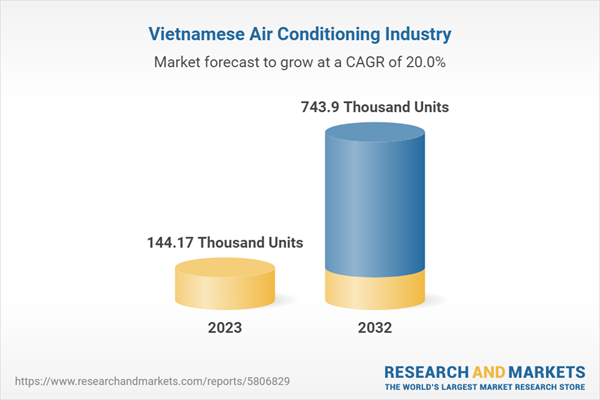Vietnam ranks fifth in the market size of the air conditioner market in the Asia-Pacific region. With several companies investing in Vietnam to set up air conditioner production bases, Vietnam's air conditioner production is gradually increasing. according to analysis, the CAGR of air conditioner production in Vietnam from 2017-2021 is 22.97%, and the production of air conditioners in Vietnam has been developing rapidly since 2020, with an annual production volume of 890,000 units, an increase of 69.94% year-on-year. in 2021, the number of air conditioners produced in Vietnam exceeds 1 million units, with a total production of 1,033,000 units, an increase of 16.31% year-on-year.
From the demand side, according to analysis, the CAGR of demand for air conditioners in Vietnam from 2017-2021 is -0.86%, and there has been a small decline in the demand for air conditioners in the Vietnamese market in recent years. After a 19.39% growth in demand for air conditioners in Vietnam in 2019, the Vietnamese air conditioner market began to shrink due to the impact of COVID-9, and the demand for air conditioners in Vietnam fell to 1.877 million units in 2021, down 12.82% year-on-year.
In terms of market type, the air conditioning industry can be divided into room air conditioners, ducted air conditioners, ductless air conditioners, and central air conditioners. In the Vietnamese market, room air conditioners dominate and are expected to remain dominant in the coming years. Central air conditioners are expected to be the fastest growing of all types. In terms of applications, residential air conditioners dominate the market and are expected to remain dominant in the coming years; commercial and retail are expected to have a faster growth rate.
According to the analyst, the market size of air conditioning industry will reach US$ 743.38 thousand in 2032 and the CAGR in 2023 to 2032 is 20.0%.
The analyst estimates that the Vietnamese air conditioning market will reach $2.4 billion by 2023, with fierce competition from Japanese, Chinese and Korean brands taking a large share of the market and domestic brands dominating the market, including ''newcomer'' Karofi. The growth of the Vietnamese air conditioner market can be attributed to the fact that the market is growing. The growth of the Vietnamese air conditioning market can be attributed to the growth in tourism and hospitality, the development of energy-efficient air conditioners, the increase in Vietnam's urban population and rising temperature levels. Increasing disposable income, changing lifestyles, and increasing technological innovations are other factors contributing to the growth of the air conditioning market in the country.
Topics Covered
- Vietnam Air Conditioning Industry Overview
- The economic and policy environment of Vietnam's air conditioning industry
- What is the impact of COVID-19 on the Vietnamese air conditioning industry?
- Vietnam Air Conditioning Industry Market Size 2023-2032
- Analysis of major Vietnamese air conditioning industry manufacturers
- Key Drivers and Market Opportunities in Vietnam Air Conditioning Industry
- What are the key drivers, challenges and opportunities for the air conditioning industry in Vietnam during the forecast period 2023-2032?
- Which companies are the key players in the Vietnam Air Conditioning Industry market and what are their competitive advantages?
- What is the expected revenue of Vietnam Air Conditioning Industry market during the forecast period 2023-2032?
- What are the strategies adopted by the key players in the market to increase their market share in the industry?
- Which segment of the Vietnam air conditioning industry market is expected to dominate the market in 2032?
- What are the main negative factors facing the Vietnamese air conditioning industry?
Companies Mentioned
- Daikin
- Panasonic
- LG
- Samsung
- Gree Electric
- Midea
- Carrier Vietnam
- Sharp
- Electrolux
- Aqua
- Reetech
Methodology
Background research defines the range of products and industries, which proposes the key points of the research. Proper classification will help clients understand the industry and products in the report.
Secondhand material research is a necessary way to push the project into fast progress. The analyst always chooses the data source carefully. Most secondhand data they quote is sourced from an authority in a specific industry or public data source from governments, industrial associations, etc. For some new or niche fields, they also "double-check" data sources and logics before they show them to clients.
Primary research is the key to solve questions, which largely influence the research outputs. The analyst may use methods like mathematics, logical reasoning, scenario thinking, to confirm key data and make the data credible.
The data model is an important analysis method. Calculating through data models with different factors weights can guarantee the outputs objective.
The analyst optimizes the following methods and steps in executing research projects and also forms many special information gathering and processing methods.
1. Analyze the life cycle of the industry to understand the development phase and space.
2. Grasp the key indexes evaluating the market to position clients in the market and formulate development plans
3. Economic, political, social and cultural factors
4. Competitors like a mirror that reflects the overall market and also market differences.
5. Inside and outside the industry, upstream and downstream of the industry chain, show inner competitions
6. Proper estimation of the future is good guidance for strategic planning.

LOADING...
Table Information
| Report Attribute | Details |
|---|---|
| No. of Pages | 60 |
| Published | May 2023 |
| Forecast Period | 2023 - 2032 |
| Estimated Market Value in 2023 | 144.17 Thousand Units |
| Forecasted Market Value by 2032 | 743.9 Thousand Units |
| Compound Annual Growth Rate | 20.0% |
| Regions Covered | Vietnam |
| No. of Companies Mentioned | 11 |









